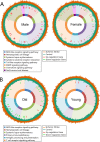Integrated analysis of ischemic stroke datasets revealed sex and age difference in anti-stroke targets
- PMID: 27672514
- PMCID: PMC5028792
- DOI: 10.7717/peerj.2470
Integrated analysis of ischemic stroke datasets revealed sex and age difference in anti-stroke targets
Abstract
Ischemic stroke is a common neurological disorder and the burden in the world is growing. This study aims to explore the effect of sex and age difference on ischemic stroke using integrated microarray datasets. The results showed a dramatic difference in whole gene expression profiles and influenced pathways between males and females, and also in the old and young individuals. Furthermore, compared with old males, old female patients showed more serious biological function damage. However, females showed less affected pathways than males in young subjects. Functional interaction networks showed these differential expression genes were mostly related to immune and inflammation-related functions. In addition, we found ARG1 and MMP9 were up-regulated in total and all subgroups. Importantly, IL1A, ILAB, IL6 and TNF and other anti-stroke target genes were up-regulated in males. However, these anti-stroke target genes showed low expression in females. This study found huge sex and age differences in ischemic stroke especially the opposite expression of anti-stroke target genes. Future studies are needed to uncover these pathological mechanisms, and to take appropriate pre-prevention, treatment and rehabilitation measures.
Keywords: Anti-stroke target; Ischemic stroke; Sex and age difference.
Conflict of interest statement
The authors declare there are no competing interests.
Figures



References
-
- Akira S, Hirano T, Taga T, Kishimoto T. Biology of multifunctional cytokines: IL6 and related molecules (IL1 and TNF) FASEB Journal. 1990;4:2860–2867. - PubMed
-
- Barker-Collo S, Bennett DA, Krishnamurthi RV, Parmar P, Feigin VL, Naghavi M, Forouzanfar MH, Johnson CO, Nguyen G, Mensah GA, Vos T, Murray CJ, Roth GA, GBD 2013 Writing Group. GBD 2013 Stroke Panel Experts Group Sex differences in stroke incidence, prevalence, mortality and disability-adjusted life years: results from the global burden of disease study 2013. Neuroepidemiology. 2015;45:203–214. doi: 10.1159/000441103. - DOI - PMC - PubMed
LinkOut - more resources
Full Text Sources
Other Literature Sources
Research Materials
Miscellaneous

